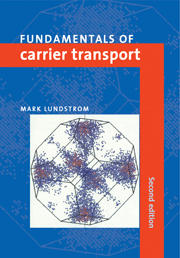Book contents
- Frontmatter
- Contents
- Preface to the second edition
- Preface to the first edition
- An overview
- 1 The quantum foundation
- 2 Carrier scattering
- 3 The Boltzmann transport equation
- 4 Low-field transport
- 5 Balance equations
- 6 Monte Carlo simulation
- 7 High-field transport in bulk semiconductors
- 8 Carrier transport in devices
- 9 Transport in mesoscopic structures
- Appendix 1 Summary of indicial notation and tensors
- Appendix 2 Some useful integrals
- Index
8 - Carrier transport in devices
Published online by Cambridge University Press: 30 March 2010
- Frontmatter
- Contents
- Preface to the second edition
- Preface to the first edition
- An overview
- 1 The quantum foundation
- 2 Carrier scattering
- 3 The Boltzmann transport equation
- 4 Low-field transport
- 5 Balance equations
- 6 Monte Carlo simulation
- 7 High-field transport in bulk semiconductors
- 8 Carrier transport in devices
- 9 Transport in mesoscopic structures
- Appendix 1 Summary of indicial notation and tensors
- Appendix 2 Some useful integrals
- Index
Summary
Carrier transport in semiconductor devices is complicated by the rapid spatial and temporal variations that often occur. For large devices, the low- and high-field transport theory developed in previous chapters is directly applicable. Such devices can be analyzed by drift–diffusion equations with field-dependent mobilities and diffusion coefficients. Transport in small devices, however, differs qualitatively from that in bulk semiconductors because the carrier distribution function is no longer determined by the local electric field. Since transport is nonlocal in both space and time, conventional drift–diffusion equations do not apply, but new possibilities for enhancing device performance arise.
In this chapter, we explain why the drift–diffusion equation loses validity for small devices and describe some important features of carrier transport in the presence of rapidly varying fields. The objective is to gain an intuitive understanding of carrier transport in modern devices such as small bipolar and field-effect transitors. To identify the kinds of transport problems that need to be addressed, we begin by describing a generic transistor. We then examine carrier transport under several specific situations that occur in modern devices and explain why the drift–diffusion equation often loses validity. Finally, we briefly examine device simulation to indicate how the transport equations are formulated for numerical solution, so that nonlocal transport can be simulated for realistic devices.
A simple, conceptual model for a transistor consists of a carrier injector, a carrier collector, and a control region that meters the flow of carriers out of the source (Fig. 8.1).
- Type
- Chapter
- Information
- Fundamentals of Carrier Transport , pp. 315 - 362Publisher: Cambridge University PressPrint publication year: 2000
- 1
- Cited by

